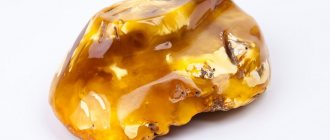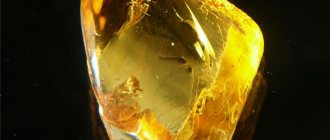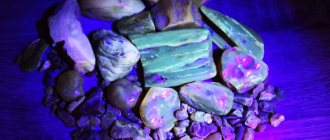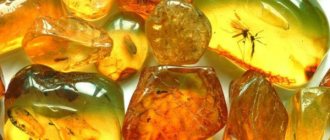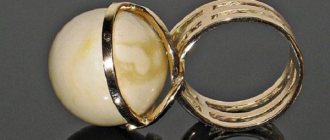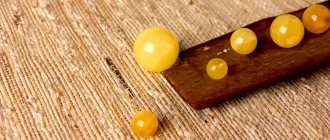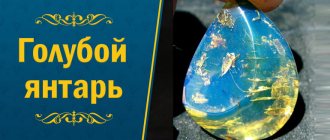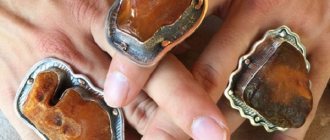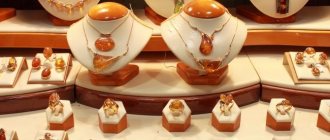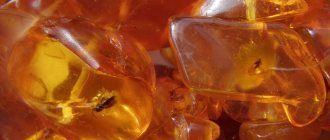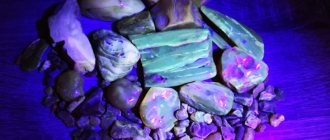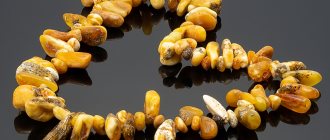Amber
- petrified fossil resin, hardened resin of the oldest coniferous trees of the Upper Cretaceous and Paleogene periods. It is used mainly for the manufacture of jewelry and haberdashery, costume jewelry; It is also used in small quantities in pharmaceuticals and perfumery, in the food, chemical and electronics industries.
- Structure
- Properties
- Morphology
- Origin
- Application
- Classification
- Physical properties
- Optical properties
- Crystallographic properties
See also:
Amber
– price and medicinal, magical properties
Physical properties and structure of diamond
PROPERTIES
Birefringence, dispersion, and pleochroism are absent. The absorption spectrum cannot be interpreted. Luminescence is bluish-white to yellow-green, in birmite it is blue. Flammable - ignites from the flame of a match. Electrified by friction. Excellent polishing. In the open air, it actively oxidizes (aging), which over time leads to changes in the chemical composition, color, and increased fragility.
MORPHOLOGY
One of the significant criteria of distinction, important for technical qualification, is the fragility number of the fossil resin. It is determined using a microhardness tester, calculated in grams, and varies from values exceeding 200 g (in the case of viscous resins such as succinite) to values of the order of 20-50 g in the case of brittle resins such as gedanite.
Amber is also characterized by a degree of transparency associated with the unequal concentration of microscopic voids in its body. On this basis, amber can be called: “transparent” - without voids, of the highest quality “cloudy” - translucent, with a cavity density of 600/mm2 “bastard” - opaque, with a cavity density of 2500/mm2 “bone” - opaque, resembling ivory in color bone, with a cavity density of 900,000/mm2 “foamy” - opaque, resembling sea foam in appearance, with various cavities from the smallest to very large, several mm in size. Amber is also distinguished by color: there are no fewer shades of amber than there are colors in the spectrum. The reason for such diversity is usually the presence in the body of amber of substances and minerals foreign to the resin. For example, sulfur pyrites or algae give amber a greenish tint. Some minerals can even give amber a special silvery tint.
According to other characteristics, “Overburden amber” is sometimes distinguished - it lies in layers later than the typical bearing layer, samples are distinguished by a thick weathering crust; “Rotten amber” is a variety that is, as it were, transitional from succinite to gedanite (gedano-succinite), sometimes “rotten amber” is mistakenly called gedanite; “Unripe amber” - otherwise crantzit.
Inclusions are often found in amber, so-called “inclusions” - arthropods stuck to a drop of resin were covered with new portions of resin, as a result of which the insect died in a quickly solidified mass, which ensured good preservation of the smallest details. Inclusions larger than 10 mm allow the stone to be classified as precious.
Amber in magic and treatment of diseases
In healing and occult sciences, as well as in astrology, sunstone is highly valued due to its unique composition and long history of use, folk traditions and beliefs. In modern medicine there is a place for the beneficial properties of amber.
Treatment with amber
Small stones are used for treatment: Pixabay
The father of medicine, Hippocrates, pointed out the healing properties of amber. It has not been proven by science, but with the help of amber they treat:
- Diseases of the upper respiratory tract and thyroid gland.
- Diseases of the central nervous system.
- Stress and chronic fatigue.
- Any form of arthritis and rheumatism.
- Blood diseases and weak immunity.
In folk medicine it is recommended to use amber as follows:
- Place a yellow pebble in your newborn's crib to promote sleep and relieve teething pain.
- Use amber amulets to protect children from diseases.
- Fumigate a child with amber for fear, stuttering and troubled sleep.
- Apply amber plates to your temples to relieve headaches.
- Adults are recommended to wear amber on their chests to stimulate vital activity and strengthen overall tone.
- It is better for mature people to put amber on their hands for longevity and prevention of senile dementia.
With the help of amber, diseases are diagnosed: the stone is hung on a thread and with the help of such a pendulum, sore spots on the human body are found.
Amber talismans
Amber is used in witchcraft and magical rituals, and amulets are prepared from it. Olga Yankovskaya, the winner of the 17th season of the Ukrainian “Battle of Psychics,” recommends this valuable stone as a talisman.
For magicians, amber is like a wise old man: it contains a huge store of strength and knowledge. The most powerful ingredient in magical recipes is reddish amber with a scorpion inside. Stones with air bubbles - containers of good spirits - are also good.
Amber is also used in traditional religion. Patriarch Nikon of Moscow and All Rus' had a staff made of amber, which he rarely parted with.
Inexpensive amber was melted along with incense during Christian rites. Previously, it was often used at weddings, driving away poverty, childlessness and envy from the newlyweds. Amber was used to attract love.
Amber is recommended to be worn by brides to protect the future family home. The stone heals energy, calms, helps control emotions. It makes people more compassionate and empathic.
In astrology, amber is the stone of the Sun. It suits all signs without exception, but most of all Leo and Cancer. The only sign that should not wear amber all the time is Taurus.
ORIGIN
The initial act in the formation of amber was the abundant release of resin from conifers. The reasons for it are very diverse. The main one should be considered a sharp warming of the climate. Pines were also sensitive to external influences. During thunderstorms, hurricanes and similar phenomena, they secreted resin-sap, which had a protective function: quickly hardening, the resin dried on the affected area, protecting the tree from infection through the wound. The bulk of the resin flowed from trees broken during the spring windbreaks. Resin flowed no less abundantly when various forest pests gnawed, pierced and gouged the bark. The trees were forced to heal the wounds inflicted on them. Thick sticky resin formed nodules, clots, clusters, and drops on the trees, which, unable to withstand their own weight, fell to the ground. Sometimes the resin release process was interrupted and resumed after some time, which contributed to the formation of multilayer resin secretions. Insects landed on the resin and stuck to it. Unable to free themselves from the sticky mass, they remained in it forever.
At the second stage, the resin was buried in forest soils. It was accompanied by a number of physicochemical transformations of the resin, the nature of which largely depended on the conditions in which the resin was exposed. In dry, well-aerated soil, the resin was transformed with the participation of oxygen. The resin's stability increased and its hardness increased. In wetlands, in anaerobic conditions, the resin retained its brittleness.
The third stage in the formation of amber is marked by erosion, transfer and deposition of fossil resins into the water basin. Conditions favorable for the emergence and accumulation of amber are associated with the geochemical and hydrodynamic specifics of the basin.
The transformation of resin into amber occurs with the participation of oxygen-containing, potassium-enriched alkaline silt waters, which, when interacting with the resin, contribute to the appearance of succinic acid and its esters in it. At the final stages of this process, not only amber is formed, but also glauconite, a mineral that constantly accompanies amber accumulations, i.e., the transformation of fossil resin into amber and the formation of glauconite occur in the same redox environment. The discovery of glauconite is evidence of a slightly alkaline and slightly reducing environment. The absence of this mineral in the rock is further evidence of intense aeration of sediments.
Compatibility with Zodiac signs
The stone will help in your personal life
Amber is the mineral and talisman of Leo. They both have one patron - the Sun. The gem is not suitable for Taurus, although there are no particular contraindications; this sign simply does not react to the energy of the stone.
Effect on other representatives of the Zodiac:
- Aries. The talisman will give this zodiac sign willpower, an inner core, which will bring success in business. It will also highlight and enhance the best sides of Aries. It is recommended to wear beads or ornamental stones in a gold frame.
- Calf. An earth sign does not react to amber, but a gem of a dark shade or completely black can protect against moral failure and rash dangerous steps.
- Twins. The representative of the air element will become more balanced, learn to complete things, and get rid of throwing around. A translucent smoky stone suits him.
- Cancer. For men and women of this zodiac sign, a transparent stone with green and blue shades is suitable. The amulet will relieve Cancer from excessive suspiciousness, anxiety, and help gain self-confidence.
- A lion. The best talisman for Leo according to the horoscope is a translucent mineral of a rich orange, yellow or red hue. An original white or milky gem in gold would also suit the sign. It will give this sign success and happiness, strengthen intuition, allow it to gain attention and respect in society, and shine in any company.
- Virgo. A set of amber jewelry will strengthen Virgo’s mental abilities, protect against stress, nervous strain, and teach how to communicate with other people. Minerals of honey, orange tones, and the color of ripe ears of corn are suitable for the earthly zodiac sign.
- Scales. This sign should choose delicate, finely handcrafted jewelry (such as silver earrings or a ring), rather than just a raw piece of amber. Such an amulet will give you self-confidence, relieve doubts and worries, and give you spiritual strength.
- Scorpion. The sign is advised to wear gems of rich colors, always with original inclusions. They will take Scorpio to a new level of spiritual development, help establish contacts with others, and make him popular.
- Sagittarius. A large mineral with a rich but uneven color is suitable for this zodiac sign. He will help Sagittarius climb the career ladder, gain authority, bring all things to an end, and realize the craziest ideas.
- Capricorn. Stones of calm tones - white, cream, lemon, gray - are suitable for a discreet sign. They will give the withdrawn Capricorn the joy of life, discover abilities that he did not know about, and increase his sociability and importance in society. It is not recommended to wear the amulet all the time, as it accumulates negative energy emanating from the owner.
- Aquarius. Small pieces of frozen resin with air bubbles inside and a smoky structure are suitable for this representative of the Zodiac. The sun stone will bring a dreamy nature down to earth, help to establish strong connections with people, and achieve a real goal in life.
- Fish. Transparent or translucent blue amber is suitable for a water sign. It will help preserve health, strengthen the entire body, raise self-esteem, increase efficiency and discover unusual talents.
Amber is a warm and reliable stone. It is recommended for any person who wants to improve their own life, get rid of worries, and find quiet family happiness. The beneficial magical and healing properties are better manifested if you believe in the power of the mineral and do not forget how important proper care is for it.
APPLICATION
Since ancient times, amber has been used to make all kinds of jewelry and household items. Amber was used to make not only wearable jewelry, but also practical items such as cigarette cases, ashtrays, caskets, caskets and even watches. The famous Amber Room occupies a special place in art.
Small grains, jewelry production waste and contaminated substandard amber are valuable chemical raw materials for the production of succinic acids, oils and rosin used in the perfume, pharmaceutical and paint and varnish industries.
Amber is also an exceptionally good electrical insulator. Its electrical resistivity is ρ = 1017 Ohm m, and the dielectric loss tangent tan δ = 0.001. Only fluoroplastic-4 can compete with amber, for which ρ = 1015-1018 Ohm m, tan δ ≤ 0.0001. Amber insulators were used (especially in the 1960s, before the widespread introduction of fluoroplastic) in the ionization chambers of X-ray meters. Typically, fused amber was used - the so-called “ambroid”.
Amber – C10H16O + (H2S)
| Molecular weight | 180.29 g/mol |
| origin of name | ambre - was borrowed by the Romans from Arabic (ʿanbar عنبر). The Arabs considered the stone to be hardened dew that fell from the sky. |
| IMA status | not confirmed |
How to wear and care for amber jewelry
Amber is most often worn in jewelry without a frame. Less often they are set in copper, even less often - gold and silver. Jewelry made from natural resin has always been popular:
- For every day, medium-sized single stones in products made in a classic style - pendants, stud earrings, rings - are more suitable.
- For a festive occasion, use large jewelry with an irregularly shaped stone.
- Wear yellow amber jewelry with a white shirt, turquoise cardigan, khaki clothes, little black dress, or outfits with fur or leather trim.
- Light amber is suitable for brown-eyed girls, and dark amber is suitable for ladies with blue, gray and green eyes.
General advice: an overabundance of amber jewelry indicates a lack of taste, so be careful when choosing products and images.
How to extend the life of a stone
Amber does not require special care, but we must remember that natural stone is fragile:
- It is recommended to store the products in a box, placing them on a soft pillow.
- Wipe them with a soft cloth slightly moistened with warm water.
- Dry after washing, blotting lightly with a towel.
- Protect from exposure to perfumes and oils. They have a negative impact on the integrity of the stone, leaving stains on the surface.
Amber is not afraid of water, you can safely wear it for a walk, take it with you to the beach or to the pool.
PHYSICAL PROPERTIES
| Mineral color | yellow-orange-brown, pale lemon yellow, red, brown, blue and green rarely |
| Stroke color | white |
| Transparency | transparent to completely opaque |
| Shine | resin |
| Cleavage | absent |
| Hardness (Mohs scale) | 2-2,5 |
| Kink | conchoidal; viscous (becomes brittle with aging) |
| Strength | fragile |
| Density (measured) | 1.05-1.09 g/cm3 |
| Radioactivity (GRapi) | 0 |
